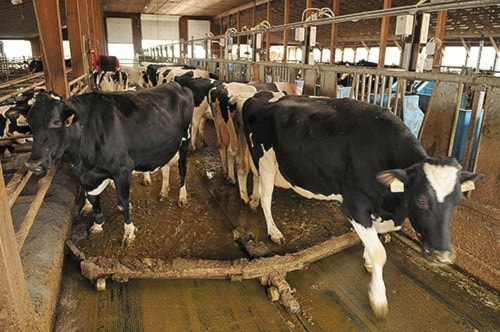Nelson Dinn gently taps a dairy cow on the back, and she shuffles happily along and out of his way.
Dinn, manager of the UBC Dairy Education and Research Centre in Agassiz, is eager to show reporters what the innovation they're using to save money while lessening their environmental impact.
Below the cow's hooves he points to a slow-moving, metal sweeper that drags up and down the barns' floors. The cows step over the sweeper nonchalantly, while it pushes their manure to an open trench at the far end. From there, the waste drops out of sight to an underground pipe to carry it away.
But the scraper isn't just pushing waste out of the barns. It's also capturing bedding sand that's been kicked out of stalls throughout the day and mixed in with the manure. On average, Dinn estimates their 500 or so cows kick out 15 kilos of sand per stall, per day.
Sand is the "gold standard" in bedding choices dairy cows, Dinn said. It's inorganic, leading to lower incidences of infections like mastitis caused by organisms like E. coli. It also provides better traction, leading to fewer falls. But sand is neither cheap, nor renewable.
So for the last year they've been extracting it from barn floor waste with a high-tech machine that cleans it with water recycled from the farm.The sand, organic material and water are each extracted through a series of steps, including the use of a Sand Cannon and a separator (the DT-360), and stored for later use. The sand can then be re-used, and the manure is ready to be used as fertilizer for the 155-hectare operation.
The innovative system has made a massive impact at the farm. They're now purchasing 80 per cent less sand, leading to lower operating costs. But the environmental impact is also impressive. Buying less sand has a trickle down effect that results in fewer truck deliveries to the farm. And the resulting fertilizer is more concentrated, requiring less transportation across the fields. The furthest field is seven kilometres from the barn, so the costs, labour and impact on the land, once again, is quite dramatic.
The UBC Dairy Farm was the first farm in Canada to install the system, created by DariTech. It's just one example of innovation at work in the farming industry.
"There's a lot of automatic equipment on farms today," Dinn said, including feeding and milking systems. Many farms are also taking a very close look at recycling their waste.
"We use automation as much as possible to make this as efficient as possible," Dinn said. Dairy farms are growing larger and farm labour is harder to find, making automation a desirable solution. As often is the case with successful innovation, economic benefits are hard to ignore; the sand recovery system in place at UBC is expected to pay for itself within seven years of first being implemented.
As an added benefit, students learning agricultural practices at UBC are learning that innovation pays off.
"They're learning that are other ways to do things," Dinn said.
jpeters@theprogress.com
